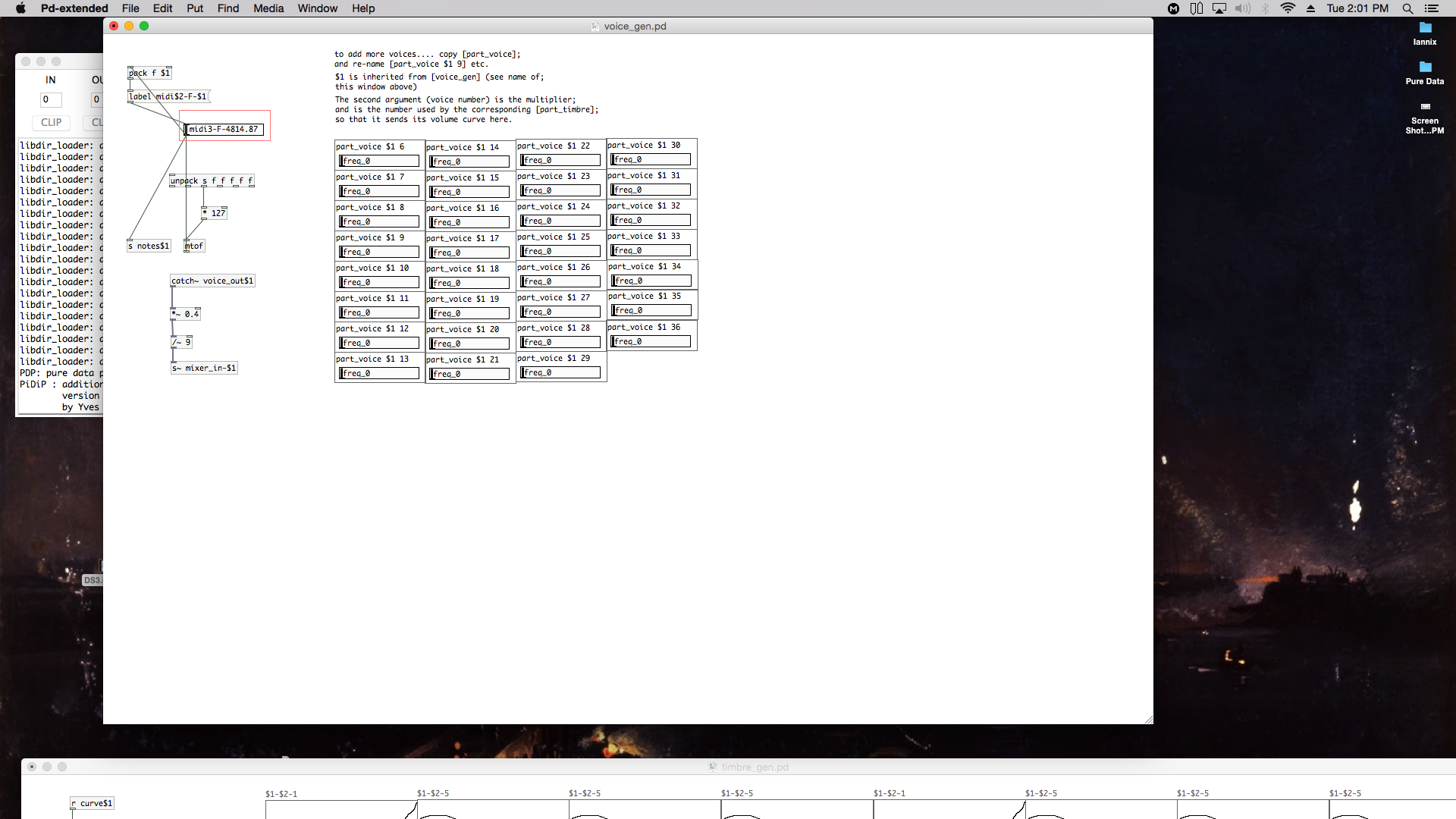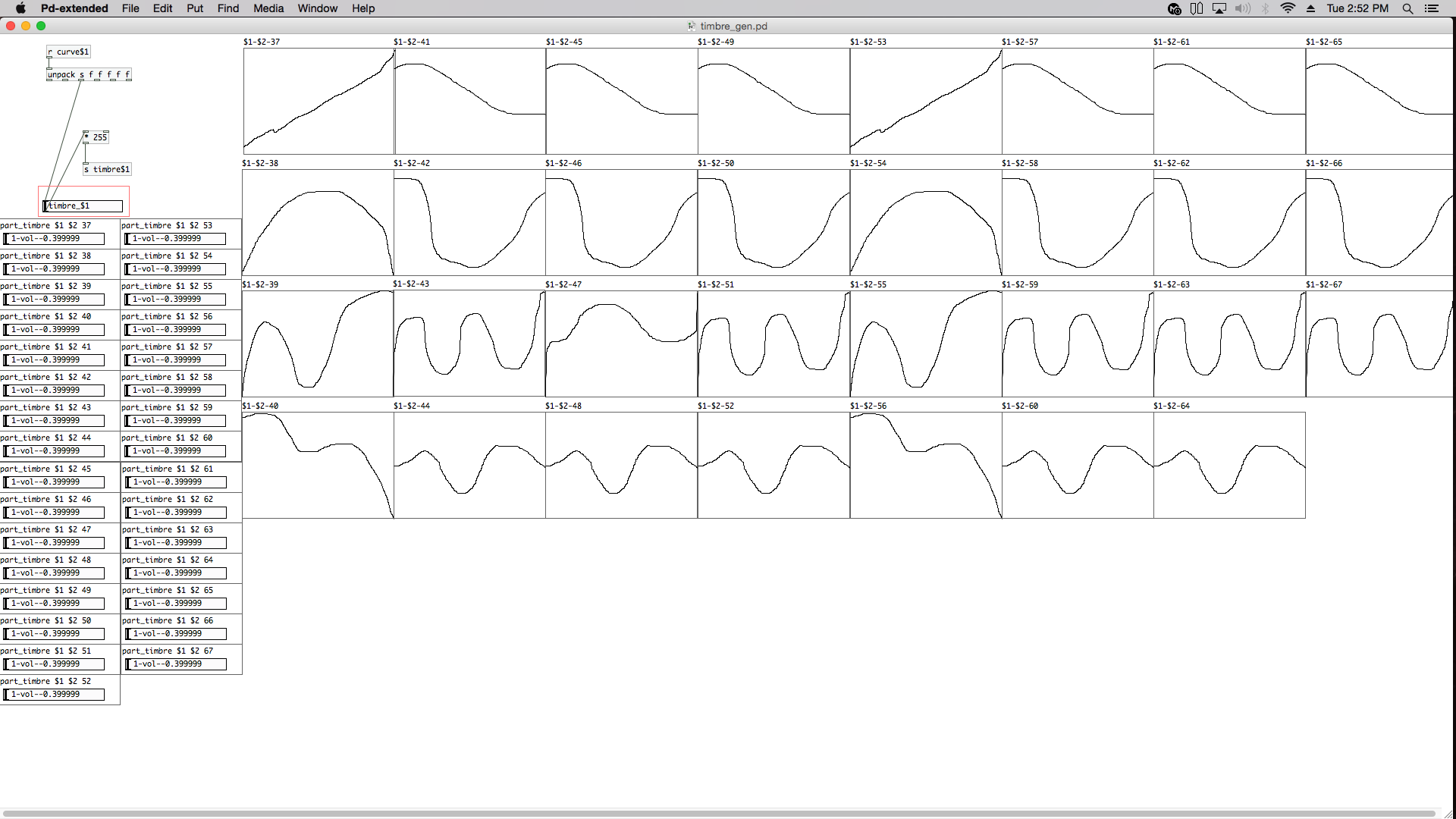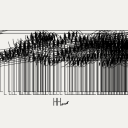Hello, the first part to this thread is this: (https://forum.pdpatchrepo.info/topic/10707/all-possible-permutations-with-repetitions-of-harmonic-volume-from-top-to-bottom)
Can someone get this patch to work? 1493807936933-combinations(3).pd 1493807936933-combinations-help(3).pd I use pd extended version 0.42.5, and I can´t get the list printed, various objects are in dotted rectangles, i tried downloading normal pd or vanilla and it didn´t work either and practically everything I tried couldn´t be created, dotted rectangles, so I came back to extended, which is the best for me when using mrpeach and Iannix which is all the time.
I´m a composer and know very little about programming, just what I need to know to make my music work...
I figure that the next step would be to put the 8 sine waves and assign each letter a volume percentage, then control the list via slider/curve.
Thank you for the help!
-
Permutations, second part, can anybody get this patch to work?
-
@whale-av it worked on your computer? the sliders moved?
-
@whale-av I guarantee were pretty close to finishing, the mistake must be pretty small
-
@Ale-H.H. I see........ a quick google finds that route does not have a (dynamic) right inlet in extended osx 0.42.5 but it does in 0.43.......... looking for a solution...
Here it is......... definitely2.zip
The bodge is a bit slow........ it works and if the data is not changing too fast it will be ok.
Maybe time for an upgrade to 0.43?...... and then you can go back to any of the previous zips.What a bitch?!
Yes, the part of the patch not working for you (until) now...... has always worked for me.....
Time for bed..... I am getting over a flu as well...... Please work!
David. -
@Ale-H.H. Better, and faster solution........ definitely3.zip
Too tired and unwell......
Gone to bed.......
David. -
hahahahah!
-
@whale-av IT WORKED! i downloaded the next version but on that it said that a lot of things couldnt be created, so i came back and tried definitely3 and it worked!!!!!! you´re awesome david!
-
@whale-av the technical side of what i imagined is now done, but the side concerning how it sounds still needs work, I want to create sound drawings that involve music without glissandi and music with glissandi, I want a fusion between these and its up to me for the composition, I love glissandi, and I want to fuse all parameters that I can think of in a sliding fashion, right now its the morphing timbre. the timbre part will be the most difficult, and it was my decision to work on it as the third parameter after pitch and intensity. As for me its common sense that for my favorite sounds, supposedly you can reach them by synthesizing and accumulating sine waves, so by this method I want to reach the sounds that i most love and morph in between them as much sounds as possible.
but this morphing timbre still needs work., the list works but on one part on the iannix score, the timbre curve was continual and the list was making jumps, is there a way for the list to "slide" from one combination to another without "jumping discretely", there will be time for jumping, but only when i want it and write it that way with vertical lines, with vertical lines in Iannix in a linear way I can jump from one place to another. -
@Ale-H.H. Hello...... another day and fewer problems I hope.
Sleep always helps!
Yes, I had thought about the jumping while I slept, and also about the inefficiency of regenerating the abcd combinations at every change of timbre.
Also, I had been stuck with the idea of using [combinations] and I did not really know why.
I believe that it is not the way forward.Now that I understand better I have totally changed the [option1] to [option2].
If you open [option2] you can draw in the curves for each oscillator with your mouse. I have put in some test curves, but of course you can change them and then re-save the [option2] abstraction.This should be far more musical. You will have to decide how the timbre should change with the curve generated by iaanix.
I will think about how to modify again so that you could set your timbre at certain points, and make the graphs redraw the morph automatically. Anything is possible...... just need to understand what is the direction of travel......
Then a system for storing the morphing curves for later re-use.New.zip
David. -
@whale-av Hello David!, I dont understand, if there are 8 curves in pd already manipulating the sine waves´s volumes, then why a curve in iannix? with my last teacher he told me to draw in iannix a curve for each volume of an oscillator, and i didn't like the idea because i want only one curve per parameter, and the more curves the less space i have in the score(I want a lot of voices in my scores and have written down 16 parameters for each, so imagine having only one voice having 16 parameters), plus with [combinations] you only need one curve because all the possible combinations are already set, and with time i would try or intuitively memorize some of the combinations and i would know where to go vertically on the score for a sound that I like. In my lifetime i want work and reach 64 sine waves´s volumes, that is way more(way more, way more) than enough, with eleven volume percentages: 0, 10, 20,30,40,50,60,70,80,90,100, isn't there a way to load the list only once and work from there? maybe right now the 64 sine waves will not occur, but gradually getting there.
here is the hypermorph ( https://www.ableton.com/en/blog/hypermorph-sonic-faction/) at 1:13 you could perceive the morphing, what we are doing is hopefully a lot more radical, they only use 4 sound sources for morphing, the combinations we are doing are a lot more... -
@whale-av I think that with one curve manipulating the whole list is more efficient, right now it doesnt have to be musical, just an exercise to get it working...
-
@Ale-H.H. i agree with David. The combinations are just linearly ordered and there is no musical information in that order. Anyhow, i replaced combinations with an updated version of baseconverter, which is much more efficient, because it only outputs the desired combination: timbres.zip. Still, to take a different approach would seem to be more promising.
-
@ingox this whole musical idea is about sliding changes, when it comes to harmonics its about morphing constantly, you have an option as well to not be linear, just jump from one sound to another with a vertical line to the desired sound and then make a horizontal line to stay there and "break" linearity and step into "musical information".
with combinations you have both options, glissando and separate steps. I think we can have both, -
@ingox the whole continuum school is about gliding, microdurations etc etc,
) an "x" shape forms as top voice decelerates and bottom one accelerates,
Examples: study 21, by Nancarrow (
Metastasis by Xenakis ()
Yuunohui'Se by Estrada
Joyas de Julia by Carrillo http://www.sonido13.com/mp3/Joyas de Julia.mp3
Miqi´Nahual by Estrada -
@Ale-H.H. I am out tonight..... so no help I'm afraid.
I start to understand.
You can assign curves to what you wish....... so?Anyway.... the last patch allows you to draw curves for each oscillator controlled by just one iaanix timbre curve.
You just have to decide how each oscillator should respond to that curve to create the timbre.
If you want the first oscillator volume to simply follow the iaanix curve then draw a line in "a" from bottom left to top right.
If you want the last oscillator to do the inverse then draw in "h" a straight line from top left to bottom right.
If you want the second oscillator volume to rise quickly as the iannix curve goes to 0.5 and then fall back to zero as the iannix curve reaches 1 then draw a triangle in "b"I hope that makes sense.
David. -
@whale-av I think I finally understand your way
-
@whale-av I added 8 more sine waves, so 16 now,,, now all of this is just for 1 voice, my score has 31 voices, can you teach me how to do this again for just another voice without having to duplicate all? what is the fastest and cleanest way? then Ill do the other 29...

-
@Ale-H.H. OK....... You are going to have to trust me on this.
This took about an hour to build........ but you can now expand it in seconds.
Abstractions are a powerful tool......... but to build them you need to understand the use of variables ($0 $1 $2......etc.)..
NEW2.zipPLEASE NOTE>>!!
Any abstraction can be copied and pasted......... .So if you want more oscillators within a [voice_gen] just copy/paste a [part_voice] within a [voice_gen] and give it a new number [part_voice $1 "x"]...... Change the pasted one's Name to [part_voice $1 "new voice number").......
It will need a timbre curve as well.... so open the relevant [timbre_gen"y"] and put a new [part_timbre $1 $2 "x"] make a new volume curve $1-$2-x by copy/pasting an existing one...draw a new curve....... and save the main [voice_gen] abstraction once you are happy.BEWARE>>!!
1..... the [timbre_gen"x"] need to be saved individually because they contain the timbre sub-curves. They cannot be used as true abstractions (they must have separate names). If you decide you want a new timbre curve for something then copy and paste an old [timbre_gen"x"], changing its name........ then change the sub-curves and re-save the file.
((this could be done better by writing data out to text files, but I don't have the time now to implement that..... this solution works.......))
2.... If you add more oscillators to a voice then you will end up with some producing ultra-sonics. If you will need to specify some new relationship between the oscillators (other than x2,x3 etc. you can do that by changing the 2nd argument for the oscillators.... i.e. [part_voice $1 0.5] etc.
Don't forget to put the "0.5" in a corresponding [part_timbre] and it's graph....!HOWEVER>>!!
I cannot help you to do this without abstractions..... it would be too difficult and too messy.
You are absolutely going to have to understand them for a project like this that is going to become very complex very fast.
See here for some help........ https://forum.pdpatchrepo.info/topic/9774/pure-data-noob/4
You will not have wasted your time.
The future benefit will be enormous...... as any sudden new idea for your patch can be working 100% just a few minutes later!.You should probably print this post before you start playing with the patch.
And please do not despair.
You will, probably after a good nights sleep, have a $ eureka moment...... and from then on you will find patching in Pd as easy as Pi....... or is that Pie?.....New2.zip should be working...... there is nothing clever or unusual.
I might not get time to help for a couple of days. If I get time to integrate a state saving system then I will integrate each [part_timbre] into each [part_voice] and the patching will become even easier.
You have 2 days to get familiar with this way of working...........
David. -
@whale-av Thanks David, I´m on it
-
@whale-av ok, so a few things, whenever I open "mix mod" there is this:error: receive~ mixer_in-$1: no matching send.
For "part timbre" there is this:throw~ voice_out$1: no matching catch
For "part voice": throw~ voice_out$1: no matching catch
and for "voice gen": throw~ voice_out0: no matching catch, I dont understand why there are several "timbre_gen" sub patches(or what are the subcurves?), other than that Im kind of understanding what i have to do to make new voices and timbres for the voices, but on the graphs when ever i need to add one, i cant change its number above the graph, I click on the graph, then properties, and there isnt a window to change the number, Ive seen the window before, but now it just doesnt appear...(this on extended), I had to open timbre-gen to change the numbers on vanilla and then re open it on extended, because on vanilla this happens in the console :
udpreceive 57120
... couldn't create
unpackOSC
... couldn't create
import mrpeach
... couldn't create
pvu~
... couldn't create
pvu~
... couldn't create
here are some pictures:



-
@whale-av I tested and there isnt any sound, ill try to repair and see where the mistake might be.



